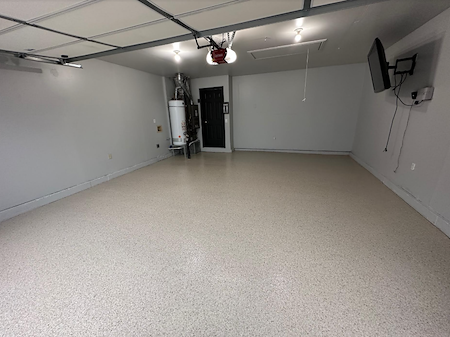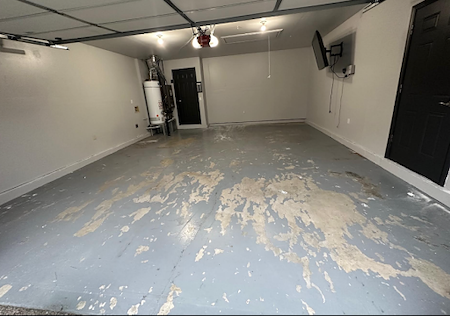How Long Do Polyaspartic Coatings Last? Pay for What You Get!

Here’s a detailed overview of the longevity of various concrete coatings, focusing on Polyaspartic coatings and comparing them with other options:
How Long Do Polyaspartic Coatings Last?
If you’re considering concrete coatings for your home or business, understanding their longevity is crucial. Many homeowners and facility managers want a durable solution that stands the test of time. In this article, we'll explore the lifespan of different coatings, including Polyaspartic, and how factors like preparation and environmental conditions impact their performance.
Concrete Coatings: Lifespan Overview
Latex Paint and Stains: Short-Term Solutions
- Latex Paint: Known for its ease of application and affordability, latex paint typically lasts up to 3 years. It often shows wear within just a few months, particularly in high-traffic areas and where vehicles are driven over.
- Latex Stains: These penetrate the concrete and last longer than paint, usually around 5 years. However, they don't offer much protection, so concrete damage remains visible.
Pros of Latex Coatings:
- Easy application
- Affordable
- Readily available at a local hardware store
Cons of Latex Coatings:
- Short lifespan
- Limited to no protection: Example: “Rust Oleum kits offer no clear coat for protection”
- Prone to peeling and fading within months of installing
- Low percentage of solids leading to more water based
Epoxy Coatings: Durable but UV Sensitive (will turn yellow from natural sun light)
- Epoxy Coatings: Durable and with moderate adhesion, epoxies last between 5 to 7 years. However, they can yellow and become hard and brittle with UV exposure.
Factors Affecting Epoxy Longevity:
- UV Exposure: Leads to discoloration and reduced durability.
- Surface Preparation: Proper cleaning and etching are essential for adhesion.
- Application: Multiple layers and correct curing times are crucial.
- Hot Tire Pick up: Epoxy does not withstand “hot tire pickup” from vehicles
Polyurea Coatings or “Hybrid” (Epoxy bottom coat and Polyurea top coat): A Solid Mid-Range Option
- Polyurea Coatings: Known for their fast curing and flexibility, polyurea typically lasts 7 to 15 years. They handle temperature fluctuations better than epoxies but may not match the longevity of Polyaspartics. Not all Polyureas or “hybrid” are UV Stable.
Best Use Cases for Polyurea:
- Garage Floors: Minimal downtime due to quick curing.
- Industrial Settings: Flexibility suits heavy machinery.
- Outdoor Patios: Better temperature tolerance.
Polyaspartic Coatings: The Long-Lasting Choice
- Polyaspartic Coatings: Leading the pack in durability, high-end Polyaspartic coatings can last 20 to 25 years. This longevity is attributed to their high solids content and superior UV stability which is 40% stronger than Polyurea. We at Floor Shield Oregon & SW Washington use only 100% Polyaspartic and do not “blend with epoxy base”.
Why Polyaspartic Coatings Last Longer:
- High Solids Content: Results in a thicker, more durable layer.
- 100% UV Stability: Maintains color and integrity under sunlight.
- Fast Curing: Reduces the chance of contamination and defects during application.
Ideal Applications for Polyaspartic Coatings:
- Driveways/Garages: Handles vehicle traffic effectively, flexible once it’s dried to allow flexibility if the ground moves.
- Commercial Floors: Perfect for high-traffic areas.
- Residential Floors: Provides long-term protection with minimal maintenance.

Importance of Proper Preparation and Installation
Proper preparation is critical for the longevity of any concrete coating:
- Preparation: Cleaning, etching, and moisture testing ensure optimal adhesion and performance.
Common Mistakes:
- Skipping moisture tests can lead to peeling.
- Poor cleaning prevents proper adhesion.
- Rushing the job affects curing and overall durability.
Benefits of Professional Installation:
- Ensures thorough preparation and application.
- Uses high-quality materials and techniques.
- Provides a warranty for added peace of mind.
Environmental Factors Influencing Coating Longevity
- Sunlight and UV Exposure: UV rays can degrade many coatings. Polyaspartic coatings are exceptional in UV stability.
- Moisture and Humidity: Can cause bubbling and peeling if not properly addressed.
- Temperature Variations: Extreme temperatures can impact coating performance. Polyurea and Polyaspartic coatings generally handle these fluctuations better than epoxies and latex.
FAQs About Concrete Coatings
- Can I Extend the Life of My Coating?: Regular maintenance helps, but choosing the right product and ensuring proper installation are more critical.
- What’s the Best Coating for Outdoor Use?: Polyaspartic coatings offer the best UV stability and durability for outdoor applications.
Conclusion: Choosing the Right Coating
Each coating type has its advantages and ideal applications. Polyaspartic coatings are the most durable and long-lasting, making them an excellent choice for high-traffic and outdoor areas. However, for shorter-term solutions or budget constraints, other options like latex or epoxy may be suitable. Evaluate your specific needs and conditions to make the best choice for your concrete surfaces.
This overview provides a clear comparison of different concrete coatings, highlighting the longevity and benefits of Polyaspartic coatings while addressing various factors that affect performance.